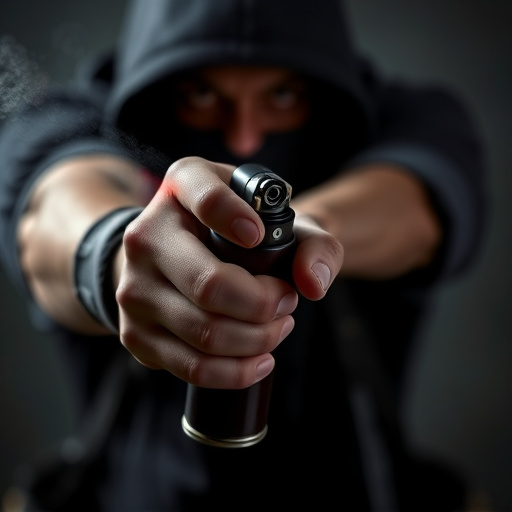Pepper spray, a powerful law enforcement tool, requires specialized training for safe and effective deployment during crowd control. Officers learn to understand its effects, maintain distance, use protective gear, and recognize de-escalation cues. Training tips focus on range awareness, activation techniques, wind patterns, and medical assistance after exposure. Responsible pepper spray usage balances public safety with individual rights, making it a strategic tool for high-risk situations while upholding stringent safety standards.
In today’s dynamic law enforcement landscape, understanding pepper spray defense training tips is paramount. This comprehensive guide explores the multifaceted world of crowd control tactics, focusing on pepper spray. From deciphering its effects and safety measures to legal considerations and effective deployment strategies, we delve into crucial aspects. We also examine hands-on training techniques and post-incident procedures, ensuring professionals are equipped to handle situations with minimal harm and maximum efficiency.
- Understanding Pepper Spray: Its Effects and Safety Measures
- Legal Considerations: When and Where Can Police Use Pepper Spray?
- Effective Crowd Control Strategies: When is Pepper Spray Necessary?
- Hands-on Training: Techniques for Safe and Efficient Deployment
- Post-Incident Procedures: Dealing with Consequences and Recovery
Understanding Pepper Spray: Its Effects and Safety Measures
Pepper spray, officially known as oleoresin capsicum (OC) spray, is a powerful tool used by law enforcement for crowd control and self-defense. When deployed, it releases a liquid aerosol containing capsaicin, the active ingredient derived from chili peppers. This irritates the eyes, nose, and respiratory system, temporarily disabling individuals and allowing officers to gain control or subdue potential threats.
While pepper spray is an effective defense mechanism, it’s crucial to understand its effects and safety measures. Proper training in pepper spray defense tips includes learning how to minimize exposure by maintaining distance, wearing protective gear, and ensuring proper ventilation during use. It’s important to know the spray’s range, activation techniques, and de-escalation strategies to handle situations effectively while mitigating risks. Regular practice in controlled environments can help individuals develop skills to respond appropriately when faced with pepper spray.
Legal Considerations: When and Where Can Police Use Pepper Spray?
In many jurisdictions, police officers are authorized to use pepper spray, also known as oleoresin capsicum (OC) spray, as a less-lethal option for crowd control and self-defense. The legal framework surrounding its usage is designed to balance public safety with individual rights. Generally, law enforcement can deploy pepper spray when they encounter situations involving potential threats, such as violent demonstrations or aggressive individuals who refuse to comply with orders.
The use of pepper spray is typically governed by specific rules, including requirements for reasonable force and proportionality. Officers must assess the risk and determine if the use of OC spray is necessary and proportionate to the perceived danger. Training in pepper spray defense is crucial for police personnel, providing them with essential skills and knowledge about the spray’s effectiveness, safe application, and potential risks. These training tips include understanding wind patterns, maintaining proper distance, and recognizing the visual cues indicating when an individual may require medical assistance after exposure to pepper spray.
Effective Crowd Control Strategies: When is Pepper Spray Necessary?
Effective Crowd Control Strategies often require a multi-faceted approach, especially in scenarios involving large gatherings or potential civil unrest. While non-lethal weapons like pepper spray are powerful tools for law enforcement, their use should be strategic and proportionate to the threat at hand. Pepper spray defense training tips emphasize responsible deployment, focusing on de-escalation as the primary goal.
When considering the necessity of pepper spray, officers must assess the crowd’s behavior and potential for violence. This includes observing factors like aggression levels, presence of known agitators, and the overall mood of the gathering. In high-risk situations where conventional control methods fail, pepper spray can be a vital tool to disrupt and disperse crowds, ensuring the safety of both citizens and officers alike.
Hands-on Training: Techniques for Safe and Efficient Deployment
In the realm of crowd control, effective and safe deployment of pepper spray is a critical skill for law enforcement officers. Hands-on training plays a pivotal role in equipping officers with the necessary techniques to manage and de-escalate volatile situations. Through interactive exercises, trainees learn the correct application methods, ensuring minimal harm to bystanders while maximizing the spray’s effectiveness against potential threats.
These training sessions delve into crucial defense tips, such as understanding wind patterns, proper distance maintenance, and identifying optimal target areas. Officers are taught to assess risks swiftly, allowing them to make swift decisions in high-pressure environments. By mastering these techniques, law enforcement personnel can confidently deploy pepper spray, acting as a game-changer in crowd control strategies while upholding the highest safety standards.
Post-Incident Procedures: Dealing with Consequences and Recovery
After a crowd control incident involving pepper spray, the focus shifts to post-event procedures and ensuring the well-being of all involved. The first step is de-escalation and medical attention for those affected by the spray. This includes both officers and protesters, as everyone’s safety is paramount. Trained professionals should handle medical assessments, providing immediate care and monitoring for any adverse reactions.
To mitigate potential long-term effects and promote recovery, Pepper Spray Defense Training Tips can be invaluable. These tips include proper decontamination methods, ensuring access to clean water, and offering psychological support services. It’s crucial to document the incident thoroughly, including video evidence and witness statements, as it aids in post-incident reviews and ensures accountability. Additionally, providing clear guidelines for future crowd control scenarios based on this experience can help prevent similar situations and promote more effective public safety measures.
In conclusion, while pepper spray can be a powerful tool in crowd control, its responsible and strategic deployment is paramount. By understanding its effects, adhering to legal guidelines, and receiving adequate training, police can effectively manage public gatherings while prioritizing the safety of all involved. These Pepper Spray Defense Training Tips are essential to ensuring its use remains necessary and proportionate, fostering a balance between public order and individual rights.
